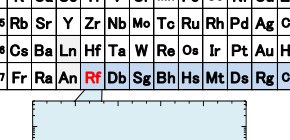
Equilibria of element 104 rutherfordium (Rf) observed
New promising experimental technique for clarifying chemical properties of superheavy elements
Elements in the same group of the periodic table have similar properties in principle, but the possibility of relativistic effects on the electronic structures is shown in the area of superheavy elements, so it’s very interesting to study their chemical properties. However, superheavy elements can only be synthesized in heavy ion fusion reactions with a very low possibility and their half-life is less than one minute, which is why only one atom can be handled in a chemical experiment (one-atom-at-a-time chemistry). Thus, chemical properties of superheavy elements are not well known. To obtain quantitative data on the level of stability of complex formations is very important in understanding chemical properties of elements, but it was difficult to obtain data at equilibrium for short-lived superheavy elements.
A group of researchers led by Assistant Professor KASAMATSU Yoshitaka and Professor SHINOHARA Atsushi at the Graduate School of Science and Team Leader HABA Hiromitsu at the RIKEN Nishina Center, succeeded in observing the equilibrium state of chemical reactions for superheavy element 104 rutherfordium (Rf) by using a new solution chemistry experiment method.
This group developed a batch-type solid-liquid extraction apparatus (which continues to feed nuclear reaction products on jet stream to a laboratory for chemical experiments of short-lived superheavy elements) for repetitive extraction experiment of element 104, Rf, and performed Rf extraction experiments using a heavy ion accelerator (which accelerates various element ions by using electric and magnetic fields to use them as high energy beams) at the RIKEN Nishina Center.
In order to obtain the distribution coefficient of a superheavy element in solid-liquid extraction, which is necessary for studying properties of complexation, this group observed the time dependence of the extraction behavior of element 104, Rf, and succeeded in obtaining the distribution coefficient of Rf in the equilibrium state.This group quantitatively compared the extraction of chloride complex of Rf in the equilibrium state with that of Rf’s homologous elements, zirconium (Zr) and hafnium (Hf). As a result, in 9 M hydrochloric acid (HCl), the distribution coefficient of Rf was found to be higher than those of its homologous elements and that, unlike Zr and Hf, Rf produced a stable chloride complex.
It is expected that this method and apparatus will elucidate chemical properties of Rf and other superheavy elements.
Abstract
We successfully observed the equilibrium state of the chemical reactions for superheavy element on a one-atom-at-a-time scale; we investigated the time dependence of the extraction behaviour of element 104, Rf. The distribution coefficient of Rf in 9 M HCl was found to be higher than those of its homologous elements, probably due to differences in the chloride complexation of Rf.
Figure 1. Current periodic table and time dependence of the extraction behavior of 261 Rf
Figure 2
To learn more about this research, please view the full research report entitled “ Observation of the chemical reaction equilibria of element 104, rutherfordium: solid-liquid extraction of Rf, Zr, Hf and Th with Aliquat 336 resin from HCl ” at this page of the Dalton Transactions website.
Related link
